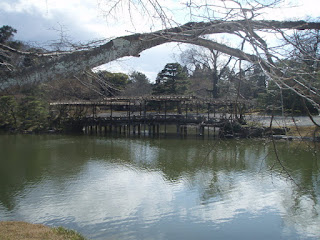The Imperial Palace
We read about the Kyoto Imperial Palace and the Sento Imperial Palace Gardens in the guide book and it was high on our list of places we wanted to visit in Kyoto. In order to visit these two restricted places, you have to apply in advance at the Imperial Household Agency, fill out a form and show your passport. We were fortunate to be able to join that day’s morning English tour of the Kyoto Imperial Palace and the afternoon Japanese tour of the Sento Imperial Palace and Gardens (which isn’t offered in English).
The tour groups with the guides were small and we were followed by a secret service looking guard to make sure no one left the path or the group. The morning guide (speaking in English) was very personable and friendly.
The Kyoto Imperial Palace originally stood at another location about 2 km to the west, but was relocated to this site in the late twelfth century. The most important building on the site is the ceremonial Shishin-den, which is flanked by two cherry and orange trees. The Mejii, Taisho and Showa emperors were enthroned here, but the current emperor has not visited in the past four years according to our guide. From the time when Emperor Kanmu moved the nation’s capital to Kyoto in 794 until 1868, the Imperial Family lived in Kyoto more than 1,000 years.
 |
| Ted with our English speaking guide |
The Sento Palace was originally built in 1630 as a retirement home for former emperors, but it burned down in 1854, leaving only the gardens and tea houses. There is one area along a pond where there are 111,000 flat oval stones laid out on the shoreline. Each stone was transported for one sho (about ½ US gallon) of rice. We can imagine this garden is even more beautiful in the spring when the cherry trees are in bloom.
Tomorrow, I want to tell you about the shopping on our trip.


















No comments:
Post a Comment